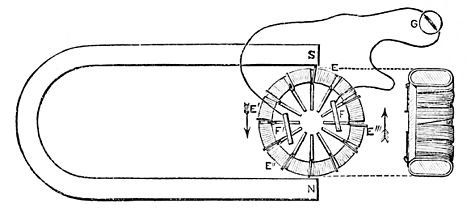Submit this annular electro-magnet simultaneously to the influence of the two poles of the permanent horseshoe magnet, N S, and at the same time imagine it to revolve on its axis in the direction shown by the arrows.
Fig. 2.

The south pole, S, of the horseshoe magnet, will produce in that portion of the ring, E, which is near it, an electric current in a particular direction, as may be inferred from what we have said respecting the straight bar, Fig. 1. But the north pole, N, of the magnet, will likewise produce in the part of the ring which is in its neighborhood, E", an electric current flowing in the opposite direction; and it is easily conceived that, in the two portions of the ring, E', and E'", which are in what may be called the mean position, there is no current at all. If, therefore, we wish to collect the two contrary currents produced simultaneously in the wire surrounding the electro-magnet, we have only to connect the wires at the mean position to two conductors by friction-contacts, F F', when the current can be carried away to a galvanometer, G, and rendered sensible.
The principle of the arrangement being thus understood, the construction of the machine itself will be readily intelligible.
It consists of a permanent horseshoe magnet, S, O, N, Fig. 3, between the poles of which revolves an electro-magnet. This electro-magnet consists of a ring of soft iron, round which is wound an insulated conducting wire, presenting no solution of continuity. It may be conceived as being an ordinary straight electro-magnet bent round in a circle, and the two ends of the conducting wire soldered together to establish continuity.
In Figs. 4 and V the electro-magnet is represented at A in section, while in Figs. 3 and 5 it is shown at A with the covering wire on it. It revolves round its axis on an axle to which movement is communicated either by means of belting, or with toothed gearing, shown in Figs. 3 and 4, worked by a handle, M.
The current is generated and collected in the following way: The wire surrounding the electro-magnet is, as we have said, continuous, but it is disposed in 40 sections or elements, each consisting, say, of
